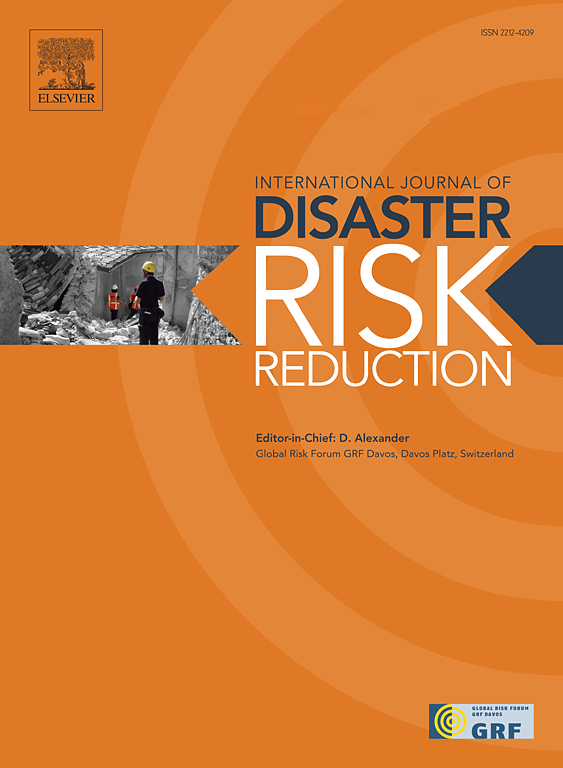Early warning services for disaster risk reduction in Brazil: The experience of CEMADEN during the floods of Rio Grande do Sul of May 2024
IF 4.2
1区 地球科学
Q1 GEOSCIENCES, MULTIDISCIPLINARY
International journal of disaster risk reduction
Pub Date : 2025-06-11
DOI:10.1016/j.ijdrr.2025.105645
引用次数: 0
Abstract
Floods are among the most expensive meteorological hazards globally and are the leading cause of disaster-related fatalities worldwide. They also result in severe health, social, and economic consequences. The unprecedented floods that occurred from April to May 2024 in the state of Rio Grande do Sul, southern Brazil, affected over 90 % of the state and resulted in 183 deaths. These floods were triggered by heavy rainfall exceeding 500 mm within five days, causing the water levels in Guaíba Lake to reach 5.35 m on May 6, the highest level since the flood in 1941. This inundation severely affected vulnerable areas of the capital city, Porto Alegre. Prior to the major flooding event in Porto Alegre, rainfall forecasts and high-risk flood warnings were issued a few days in advance. In Brazil, the Early Warning System (EWS) operates through an intersectoral, multi-agency framework. Over the past fifteen years, the integration of climate information into disaster prevention, risk reduction, monitoring, and early warning has improved significantly. However, despite the National Center for Monitoring and Early Warning of Natural Disasters (CEMADEN) being the primary institution responsible for monitoring and issuing nationwide early warnings for floods, flash floods, and landslides, there is still a need for better integration of information. This improvement could enhance response actions and contribute to resilience building. This study provides a brief review of the climatological conditions that led to the floods in Rio Grande do Sul in April–May 2024. It also examines the role of EWS and Multi-Hazard Early Warning System (MHEWS) centers in Brazil during the disaster, as well as an evaluation of CEMADEN's prevention and early warning activities before and during the event. The aim is to understand the unique nature and impacts of this disaster to better prepare for similar events in the future.
巴西减少灾害风险的早期预警服务:CEMADEN在2024年5月巴西南格兰德州洪水中的经验
洪水是全球最昂贵的气象灾害之一,也是世界范围内与灾害有关的死亡的主要原因。它们还造成严重的健康、社会和经济后果。2024年4月至5月,巴西南部南巴西格兰德州发生了前所未有的洪水,影响了该州90%以上的地区,造成183人死亡。由于5天内降雨量超过500毫米,6日Guaíba湖的水位达到5.35米,是自1941年水灾以来的最高水位。这次洪水严重影响了首都阿雷格里港的脆弱地区。在阿雷格里港发生大洪水之前,降雨预报和高风险洪水预警提前几天发布。在巴西,预警系统(EWS)通过跨部门、多机构的框架运作。近15年来,气候信息在防灾减灾、监测预警等方面的整合水平显著提高。然而,尽管国家自然灾害监测预警中心(CEMADEN)是负责监测和发布全国洪水、山洪和山体滑坡预警的主要机构,但仍需要更好地整合信息。这一改进可以加强应对行动并有助于恢复力建设。本研究简要回顾了导致2024年4 - 5月巴西南格兰德州洪水的气候条件。报告还审查了灾害期间巴西EWS和多灾种预警系统(MHEWS)中心的作用,以及对CEMADEN在灾害发生前和期间的预防和预警活动的评估。目的是了解这次灾难的独特性质和影响,以便更好地为未来类似事件做好准备。
本文章由计算机程序翻译,如有差异,请以英文原文为准。
求助全文
约1分钟内获得全文
求助全文
来源期刊

International journal of disaster risk reduction
GEOSCIENCES, MULTIDISCIPLINARYMETEOROLOGY-METEOROLOGY & ATMOSPHERIC SCIENCES
CiteScore
8.70
自引率
18.00%
发文量
688
审稿时长
79 days
期刊介绍:
The International Journal of Disaster Risk Reduction (IJDRR) is the journal for researchers, policymakers and practitioners across diverse disciplines: earth sciences and their implications; environmental sciences; engineering; urban studies; geography; and the social sciences. IJDRR publishes fundamental and applied research, critical reviews, policy papers and case studies with a particular focus on multi-disciplinary research that aims to reduce the impact of natural, technological, social and intentional disasters. IJDRR stimulates exchange of ideas and knowledge transfer on disaster research, mitigation, adaptation, prevention and risk reduction at all geographical scales: local, national and international.
Key topics:-
-multifaceted disaster and cascading disasters
-the development of disaster risk reduction strategies and techniques
-discussion and development of effective warning and educational systems for risk management at all levels
-disasters associated with climate change
-vulnerability analysis and vulnerability trends
-emerging risks
-resilience against disasters.
The journal particularly encourages papers that approach risk from a multi-disciplinary perspective.
 求助内容:
求助内容: 应助结果提醒方式:
应助结果提醒方式:


